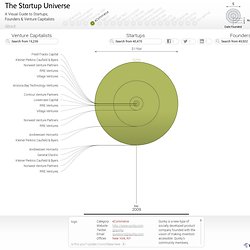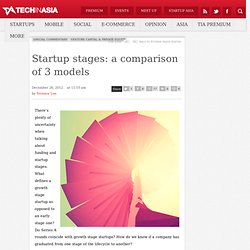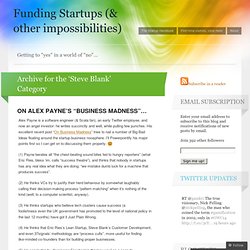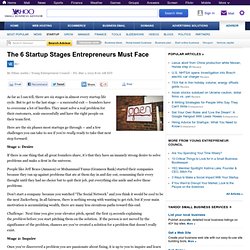

Untitled. The Startup Universe displays and explores the relationships between startup companies and their founders and investors (Venture Capitalists) since 1990.

Startups are grouped into 19 categories, based on the type of products or services they deliver. Each category is represented by an unique color. In addition to that, startups are visually sized according to the amount of financing they have raised, with each individual round displayed as well. Startups are positioned within the main interface on a horizontal interactive timeline, based on the year they were founded. Details about each company are provided below the timeline. By clicking on the left or right columns - Venture Capitalist or Founders' names - tangential stories can be explored: how many startups has a VC company funded and are there any time or startup category trends or patterns? Startups, VCs and founders can also be directly browsed by entering a name in the search field.
All data comes from the CrunchBase API. Квалиметрический подход к рейтингованию стартапов. В 20 веке перед экспертами различных стран стояла острейшая проблема нахождения надежной методологии оценивания качества, в том числе результатов деятельности творческих коллективов, их работников, продукции, проектов и услуг.

В результате в 1968 году в мире появилась научная дисциплина квалиметрия [1], спрос на использование которой существенно вырос в последнее время в связи с бурным развитием интернета и в связи с расширением областей человеческой деятельности, для которых характерна квантификация методов, средств и способов исследований. Квалиметрический метод был разработан Г.Г.Азгальдовым [2] и развит в многочисленных трудах российских и зарубежных исследователей. Поскольку методические подходы, применяемые в квалиметрии, могут быть эффективно реализованы при оценивании и отборе стартапов, особенно на ранней стадии развития, предлагается для рейтингования стартапов использовать квалиметрический анализ.
. — 1 «rating» — оценка, порядок, классификация. Авторы: Литература 1. 2. 3. 4. 5. Startup stages: a comparison of 3 models. There’s plenty of uncertainty when talking about funding and startup stages: What defines a growth stage startup as opposed to an early stage one?

Do Series A rounds coincide with growth stage startups? How do we know if a company has graduated from one stage of the lifecycle to another? Here, we take a quick look at three popular models that’s been bandied about: Funding stages (which venture capitalists talk about often), Steve Blank’s Customer Developmental Model, and Startup Genome’s Marmer Stages, a new entrant which adapts Steve Blank’s model and modifies it with self-reported data from thousands of startups. Notes: 1. This comparison is not meant to go into the details. Funding Startups (& other impossibilities) Advanced Manufacturing Growth Summit in London… This Tuesday (25th January 2011), I’ll be off to rub cheeks [*] with the great and the good of UK manufacturing at a BIS-chaired summit in London.

That ultra-lean micro-manufacturers (such as my startup Nanodome) can sensibly share governmental mindspace with über-politicized macro-manufacturers (such as Land Rover, Jaguar, etc) may at first seem paradoxical, but then again we’re all waist-deep in the same financial quagmire, so what the hey. The rationale for the summit is that there’s a government manufacturing review due in time for the coming Budget, hence the question Vince Cable, Mark Prisk et al would like attendees to help answer is simply: what can government reasonably do to assist, preferably without spending any money? But, you may say, UK manufacturing, really? Yet over the same period, the UK’s per-worker productivity vastly increased, largely (and unsurprisingly) due to a combination of automation and outsourcing.
Stages of the Startup Lifecycle - Compass. Our foundational structure of startup assessment is the startup lifecycle.

Understanding where a startup is in their lifecycle allows us to assess their progress. The startup lifecycle is made of 6 stages of development, where each stage is made up of levels of substages. This creates a directed tree structure and allows for more granular assessment by being able to pinpoint the main drivers of progress at each stage. Our first four top-level stages are based loosely on Steve Blank's 4 Steps to the Epiphany, but one key difference is that our lifecycle is product centric rather than company centric.
The 6 Startup Stages Entrepreneurs Must Face. As far as I can tell, there are six stages in almost every startup life cycle.

But to get to the last stage — a successful exit — founders have to overcome a lot of hurdles. They must solve a real problem for their customers, scale successfully and have the right people on their team first. Here are the six phases most startups go through — and a few challenges you can take to see if you’re really ready to take that next step forward: Stage 1: Desire If there is one thing that all great founders share, it’s that they have an insanely strong desire to solve problems and make a dent in the universe. People like Jeff Bezos (Amazon) or Muhammad Yunus (Grameen Bank) started their companies because they ran up against problems that ate at them day in and day out, consuming their every thought until they had no choice but to quit their job, put everything else aside and solve these problems.
Stage 2: Inquire Challenge: Find the email address of a successful entrepreneur you admire and email her. Startup stages - Google Search.